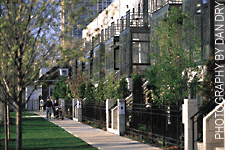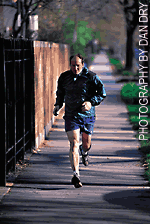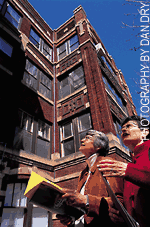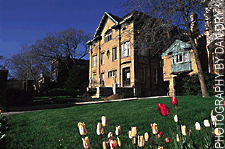In
the past five years, after a half-century
of disdain and indifference, much of the South Side--especially
this university community--has taken off, becoming a "hot" neighborhood
in a "hot" city. Plummeting crime rates, good public and private
schools, and an array of vintage and new housing stock are some
of the attractions. There's also the lure of an integrated community
close to the lake--an easy commute to downtown, a host of cultural
institutions and parks, and the Midwest's best bookstores. Taken
together, they make Hyde Park-Kenwood, if not the city's hottest
real-estate market, one with lots of appeal. In neighborhoods
where for decades the goal was to get developers to invest, people
now worry about how best to ward off the unwanted side effects
of burgeoning development. In short, the people who used to say,
"I would never buy there," now say, "I wish I had bought something
there."
 |
| Kenwood--
an
anchor to bank on |
Dyrud's
not a real-estate agent. She doesn't sell property. A straight-talker,
she simply helps University faculty and staff find what they're
after, sometimes putting buyers and sellers in contact, but mostly
just introducing newcomers to the community, giving them perspective
about the neighborhood, where it's been and where it's going.
"I
used to tell people that the Hyde Park market was very soft, everything
was negotiable," she informs Chase, "but lately people have been
getting their asking price." As they scan the street numbers on
Greenwood she describes properties on the block that have sold
recently, what they went for, who lives there now. The vintage
row houses on the west side that sold for $200,000 in the 1970s
now sell quickly for two to three times that.
"I
have been told," asks Chase, cagily, "that Hyde Park is 'surrounded
by danger.' Is that true?"
"There's
Mrs. Hamp," says Dyrud, searching the block for a vacant spot.
"Her husband is a professor emeritus of linguistics. They say
he speaks 22 languages.
"Quite
a few faculty live on this block," she continues. "Right over
there..."
"You're
not answering my question."
"Just
a second. I'm coming to that," she answers, backing cautiously,
but optimistically, toward the curb.
It's
not a question one can answer while parallel parking. For nearly
50 years Hyde Park has had a reputation as an island fortress,
surrounded by poverty and crime, gangs and drugs, unemployment
and urban decay. This reputation was never entirely true, as South
Shore and Chatham, among others, have always been solidly middle-class
neighborhoods, but major problems were apparent. Indeed, in the
1950s, Hyde Park had the second-highest crime rate of the city's
39 precincts. There was even discussion of abandoning the campus,
selling the buildings, and moving the entire intellectual enterprise
out of the South Side-perhaps to sunny California.
During
the mid-1950s and '60s, however, a sustained program of urban
renewal was masterminded by the late Julian H. Levi, PhD'29, JD'31,
a prominent Chicago lawyer who was appointed executive director
of the newly formed South East Chicago Commission. Using massive
investments by the University, the city, and the federal government
to stabilize the immediate neighborhood, the process-- primarily
buying up and tearing down blighted properties and assembling
what became the state's largest private security force, policing
not just the campus but also the surrounding neighborhoods--succeeded,
but took with it much of the area's retail and artistic vitality.
Parts of 55th Street, once the main commercial strip, known for
its jazz clubs and saloons, evolved into a long line of gray,
boxy, unwelcoming structures encircling a mid-street high-rise
complex that even the most euphemistic real-estate agents refer
to as "Monoxide Island."
Some
observers, then and later, considered the University's approach
rather draconian. In Making the Second Ghetto: Race and Housing
in Chicago 1940-1960 (1983; University of Chicago, 1998),
sociologist Arnold R. Hirsch described the often tense interplay
between the liberal idealism of many Hyde Park residents who championed
the creation of an interracial community, "transforming the inevitable
into the desirable, or at least, the acceptable," and the University's
grim determination to use urban renewal to "restructure and control
its neighborhood," preserving a "compatible environment" for education
through a process dubbed "slum prevention."
 |
| Hank
Webber, the
U of C's vp for community
affairs, takes a jog through the 'hood. |
A
subsequent book by U of C sociologist Richard P. Taub on the survival
and recovery of threatened communities focused on the effectiveness
of this determined approach. In Paths of Neighborhood Change:
Race and Crime in Urban America (University of Chicago Press,
1987), Taub studied several urban neighborhoods that had faced
a similarly rapid influx of disadvantaged minorities and high
crimes rates yet managed to avoid financial collapse. The key
to economic success, he discovered, was the presence of what he
called "institutional actors." These were large institutions,
in one case a shopping mall, that simply could not move away.
They all took the same actions: aggressive involvement in the
local real-estate market, removal of decayed or abandoned properties,
and increased police presence.
Hyde
Park's initial phase of urban renewal ended by the mid-1960s,
when the neighborhood more or less stabilized, but the University
continues to spend millions a year ($5.7 million in 1999) for
security, employing more than 100 officers to cover the community.
In the 1990s, however, the sustained and ongoing rejuvenation
of the area has allowed the officers to focus more on prevention
and less on apprehension.
 |
| Rose
Dyrud, supervisor
of housing services, gives housing staffer Patty Crowl a tour
of East View Park. |
"We've
seen a big change," notes Bob Mason, executive director and crime
specialist for the South East Chicago Commission, which works
closely with the police to monitor law enforcement, building codes,
and zoning. "Crime has gone down all over the country, in New
York and Los Angeles as well as Chicago," says Mason, "but Hyde
Park has seen a huge drop off, much greater than the rest of the
city."
According
to statistics compiled by the SECC, violent crimes in the Hyde
Park-South Kenwood neighborhood-bounded by 61st and 47th streets,
Cottage Grove Avenue and Lake Shore Drive-decreased 57 percent
from 1975, the earliest year with good data, to 1999. Sexual assaults
dropped 67 percent, from 51 in 1975 down to 17 in 1999. Burglaries
fell 60 percent, from 784 down to 314. Robberies went from 546
down to 237. Homicides dropped from 11 in 1975 to only one in
1995, five in 1996, one in 1997, and four in 1998--followed by
a disturbing increase to nine in 1999, possibly the result of
gang-related spillover into the fringes of Hyde Park, says Mason.
In the first four months of 2000, there were two sexual assaults
and no homicides.
Even
at the lakefront, a vast, exposed, easily accessible area, crime
has "dropped off the table," says Mason. "People routinely jog
or bike, not just along the lake in Hyde Park but north of 47th."
That was considered unwise, at best, in the 1970s--even if you
were really fast.
Mason
attributes the decrease, still under way, to smarter police work
by the City and the University, the improved national economy,
and the ongoing financial recovery of the entire South Side. "The
slum-like buildings are gone," he says. "They're being replaced
by new construction."
Hyde
Park--South Kenwood now has one of the lowest rates of violent
crime per capita in Chicago, less than half the citywide average
of 2,261 per 100,000 people, making it more secure than all but
four of the city's 25 police districts. "The whole area feels
a lot safer now," insists Mason. "I don't look over my shoulder
anymore. The numbers support that feeling."
"I
walk my dog at all hours," Dyrud tells Chase, "and I've never
felt uncomfortable."
"What
kind of dog?" he asks.
"A
rottweiler."




![]()



